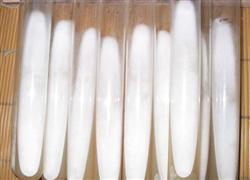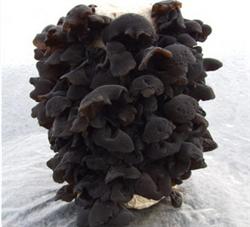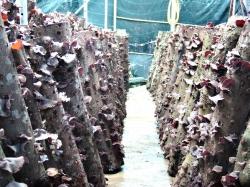Identification technique of Auricularia auricula strain

1. Hypha is white, like fine wool, short and neat, dense, strong and powerful, extending side by side to the bottom of the bottle, growing evenly, consistent from top to bottom, dug out into blocks, not loose. 2. After the mycelium grows full of bottles, brown water droplets are generally secreted on the surface of the mycelium. Later, pale yellow transparent gelatin ear buds appeared around the bottle wall and on the surface. 3. The strain column is closely attached to the bottle wall, and the bottle wall with a small amount of white water droplets is fresh strain. If there is light yellow water at the bottom of the bottle, the bacterial column shrinks from the wall, which is an aging strain and cannot be used. 4, normal strains have the unique aroma of black fungus, if there is odor and mildew, or there is plaque and spherical bacteria, is bacterial pollution, if there are other red, green, yellow, black and other colors, indicating that it has been contaminated by miscellaneous bacteria, can not be used. 5. If there is light black colloid (ear base) between the culture medium and the bottle wall, it indicates that it is a strain with early maturity or excessive expansion times. After cultivation, the ear is small, the quantity is large, it is not easy to grow up, the quality is poor, and the yield is low. It should be eliminated. 6, if the bottle can see wood particles and hyphae are few, indicating that the culture time is too short, should continue to culture. If there is no significant change after a period of culture, it indicates that the medium is undernourished and should be supplemented. If the strain grows to about half or a corner no longer continues to grow, it may be too dry or too wet. If hyphae grow orderly, dense, suddenly appear sparse, and there is a clear boundary, indicating that the upper material is moderate, the lower part is too dense.
- Prev

Seed Production Techniques of Auricularia auricula
Black fungus hanging bag cultivation 2-3 tide ear, due to the bag nutrition, lack of water no longer out of the ear, generally discarded waste material. In practice, we adopt sand coating treatment, after many tests can still produce 3-4 ears, the specific methods are as follows: take off the bacteria bag, bacteria material placed in nutrient solution soaked for a day, let it absorb enough water (nutrition).
- Next

High-yield cultivation techniques of Auricularia auricula
The sandy ground or flat grassland with warm climate, small temperature difference between day and night, moist air, sufficient sunshine, close to the water source and not affected by water damage, and the ear field with large cultivation should also take into account the traffic conditions. The land with low-lying terrain and poor drainage should not be used as an ear field. 1.2 after the establishment of the ear field, it is necessary to do a good job.
Related
- Fuxing push coffee new agricultural production and marketing class: lack of small-scale processing plants
- Jujube rice field leisure farm deep ploughing Yilan for five years to create a space for organic food and play
- Nongyu Farm-A trial of organic papaya for brave women with advanced technology
- Four points for attention in the prevention and control of diseases and insect pests of edible fungi
- How to add nutrient solution to Edible Fungi
- Is there any good way to control edible fungus mites?
- Open Inoculation Technology of Edible Fungi
- Is there any clever way to use fertilizer for edible fungus in winter?
- What agents are used to kill the pathogens of edible fungi in the mushroom shed?
- Rapid drying of Edible Fungi

